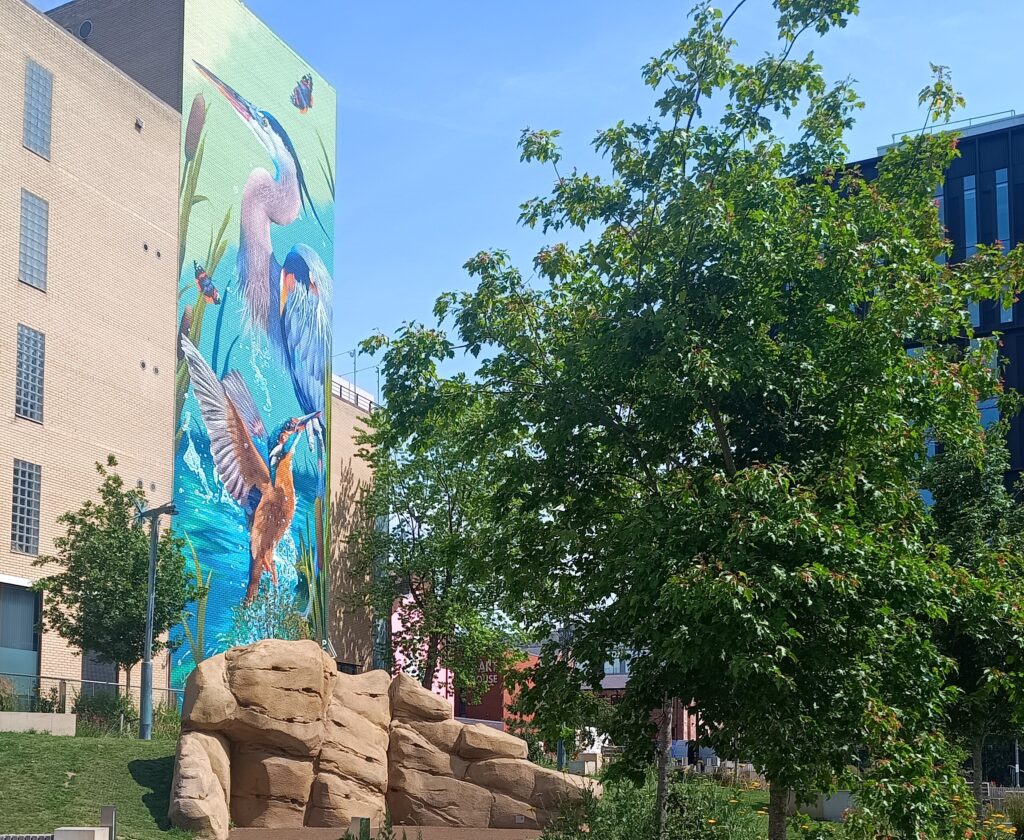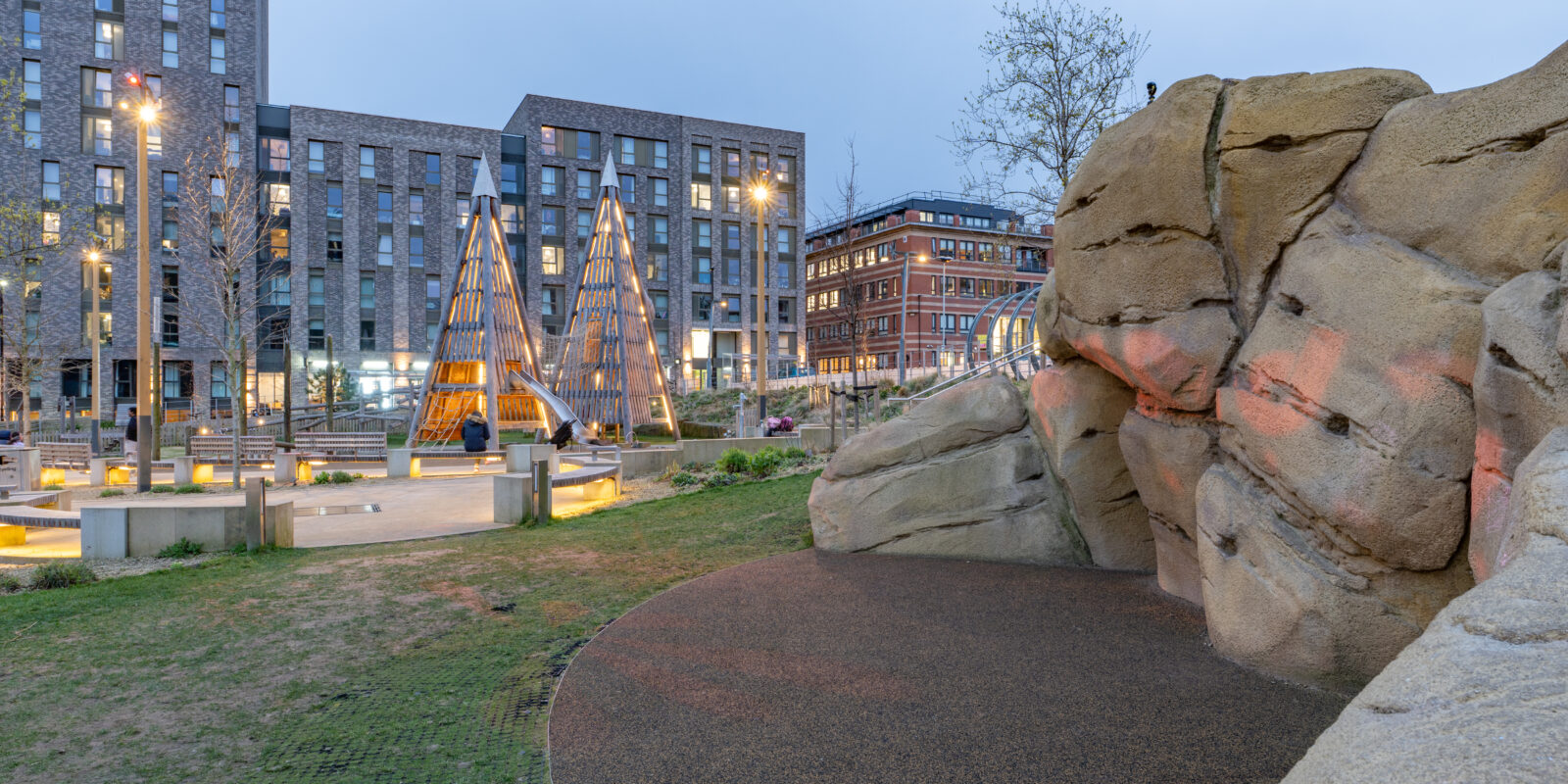Image credit: Paul Upward
A city centre landscape designed for play and social interaction, built as an inclusive space with children, young people and families in mind.
The rationale for taking a child-friendly approach
Pound’s Park sits at the heart of Sheffield city centre and marks a bold commitment by Sheffield City Council to embed child-friendly principles into urban regeneration. Originally earmarked for a multi-storey car park and commercial development, the site was reimagined during the COVID-19 pandemic when a key anchor store withdrew from the area. This pivot presented an opportunity to create a new kind of city space—one prioritising play, community use and public art over cars and retail.

Pound’s Park mural by artist Peachzz. Credit: A Place in Childhood
With Sheffield’s city centre population growing significantly over recent years, it was recognised that the need for high-quality public space was urgent. Pound’s Park fills a critical gap in city centre provision and is part of a wider public sector-led regeneration initiative, Heart of the City.
The planning process
The project was managed in-house by Sheffield City Council’s Capital Delivery Service and City Regeneration & Major Projects Team, with funding from central government via the Get Building Fund and Transforming Cities Fund. Sheffield City Council granted planning permission, with planners noting the scheme was fully in line with local and national policy and guidance and would make a significant contribution to the use and attraction of the city centre.
Early RIBA stages were led by the Council’s in house landscape team with ARUP providing engineering input. Later stages were completed under a Design and Build contract with Henry Boot Construction, with Planit-IE taking over landscape delivery.
Design collaborators included Julian Stocks (lighting and public art), RivelinCo (creative engagement), Timberplay (play equipment), and Whittam-Cox Architects (toilet block). Longstanding relationships between Sheffield’s design teams and local suppliers supported continuity in quality and vision.
Engagement with children and young people
Pandemic constraints limited the types of early public engagement, but meaningful engagement with children and young people occurred in the final public art installations in Pound’s Park. RivelinCo, a Sheffield-based arts organisation, coordinated creative workshops with over 500 people, including many children eligible for free school meals. Participants contributed artwork and poetry on the theme of Sheffield’s past and future. Ninety pieces were selected and cast into bronze roundels now embedded in the park. You can watch a video about the process below:
Workshops included haiku writing, drawing and creating 3D artwork, and involved all generations. Some young people working on the project met the metalwork artist Julian Stocks who came up with the overall vision and made the final pieces. The process helped children from underrepresented communities feel a sense of belonging in the city centre and those that contributed were invited to the Park’s launch event. One young person noted:
‘In the workshop with Rivelinco, we had to draw things that we liked and I drew a butterfly and it’s now in the park and like many people and many generations will come and see it. My favourite part [of Pounds Park] is the water. It’s so exciting!‘
Additional input came early on from ‘Our Bodies, Our Streets’, a youth-led group advocating for women and girl’s safety. Their ideas shaped lighting design, sightlines and feelings of being welcome at night. A blog from Make Space for Girls highlights the park’s lighting as an exemplary example of design supporting safety.

Pound’s Park at night. Credit: Emma Beaumont
How children and young people informed the design
The influence of young people and consideration of their right to play is visible in the space’s many creative and playful features. Timberplay, a Sheffield-based company, provided the equipment and supported discussions of how to embed it into the wider landscaping and site design. The core equipment is made from high-quality natural materials and includes water and sand play, musical steps, sensory stepping stones and a climbing rock provided by Rockworks. The bronze roundels created through the public art engagement and lighting projections invite interpretation and encourage exploration.

Water and sand play in Pound’s Park. Credit: Oliver Ibbotson
Pound’s Park demonstrates how designing for curiosity and self-directed play can enhance child-friendliness across an entire site. The park also features thoughtful landscape design inspired by the Peak District and the planting is deliberately low-maintenance, requiring two cuts a year, and resilient. Dry stone walls and oak estate railings subtly contain the space without fencing it off or enclosing children in.
Outcomes
Since opening in 2023, Pound’s Park has become a beloved city destination. Families, schools and nurseries use it regularly. Toilets and a pop-up café enhance dwell time and the park is connected to wider developments like the Cambridge Street Collective food hall. In a video released by local newspaper, The Star, visitors noted on the opening:
‘This is a really good little spot to be in in the middle of town, I’ve got the dog, I’ve got my grandson, and my granddaughter – climbing. And yes, it’s free!’
‘I think it’s brilliant to have something like this in the city centre. I will be bringing my son into town now to come here. You just need something different sometimes. We got the bus into town just for this.‘
‘We obviously love it. There needs to be more to come into town for that you don’t have to drag the kids to.‘
Ambassadors employed by city centre management check the park daily, offering light-touch safety and maintenance presence. The lighting strategy means the space is safe and welcoming in the evening and young people are regularly seen using it after dark.
The public art and mural have become iconic of the city centre. Feedback from the public has been overwhelmingly positive, and Pound’s Park offers a replicable model for how city centres can prioritise families and children within inclusive, high-quality public space.
Learning for other places
Planning and design
- Design for whole-site play: Children will use all elements of a space for play—not just designated equipment. Designers should expect and support playful interaction with features like planting, lighting and drainage.
- Balance boldness with practicality: Features like loose materials and natural elements (e.g. sand, gravel, water, timber) require careful planning but offer rich play value. Holding firm on these elements can deliver long-term benefits when paired with thoughtful detail design.
- Prioritise inclusivity through design: Lighting design, permeability and visual openness should be approached as inclusive tools. Lighting can support safety, while maintaining an unfenced site allows intergenerational use and avoids a sense that children and young people must only be in specific zones.
- Integrate play into wider regeneration: Pound’s Park succeeds because it’s embedded in a wider city centre strategy that includes traffic calming, housing growth and active travel infrastructure. Play should be seen as central infrastructure, not an add-on.
- Leverage in-house expertise where possible: Sheffield’s in-house design team enabled continuity and a strong place-based identity. Other authorities could benefit from maintaining or re-establishing similar capabilities—or building deep partnerships with trusted suppliers.
Community engagement and public art
- Use creative participation to overcome constraints: RivelinCo’s work showed how creative workshops and public art can meaningfully engage a wide demographic.
- Celebrate visibility and permanence: Embedding young people’s creative work into the fabric of the site—via bronze roundels and projections—offers a powerful sense of ownership and legacy.
- Manage scale and expectations carefully: While involving over 500 people was impactful, future projects may benefit from deeper engagement with fewer participants to support fuller co-design and reduce delays or disappointment in selection processes.
- Create stories and symbols: The combination of haikus, heritage references (like steel sparks) and artistic lighting created a strong narrative identity for the park. These elements help embed the site in the collective imagination of the city.
Management and maintenance
- Plan for ongoing stewardship early: Roles like ambassadors, daily safety checks and responsive maintenance (e.g. managing water play or litter) are essential to the park’s continuing success and safety. The project team notes that the costs were initially underestimated, particularly with regard the sandpit and toilets.
- Low maintenance planting delivers high value: A simple biannual cut regime works here because of careful species selection, resilience to footfall and embedded drainage strategies.
- Facilities matter: Public toilets, changing facilities and a tap for washing hands after water play are key highlights of the park for families. These need to be funded and maintained with long-term budgets in mind.
Strategic framing and advocacy
- Position play as core urban infrastructure: The park was funded through major regeneration packages (Get Building Fund and Transforming Cities Fund), showing that play can sit within broader economic and connectivity goals—not just leisure.
- Use evidence of impact to build future support: The unexpectedly high use by schools and nurseries, and positive media coverage, offer compelling narratives that other authorities can use to make the case for investment.
- Frame the park as a city asset, not a niche space: Pounds Park helps position Sheffield as a city investing in quality of life. Strategic leaders can frame child-friendly design as a signal of civic ambition and wellbeing.

